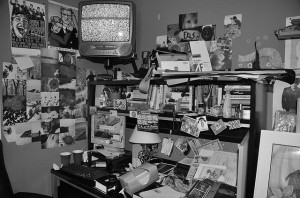We know that Six Sigma can help an organization accomplish large and ambitious projects. When we think of Six Sigma in action we think of Black Belts and their teams creating charters that encompass the operations of dozens, or hundreds of employees, complex data collection plans that gather a vast amount of information, and potential cost savings and financial benefits in the millions.
All of this is true. Organizations can indeed apply Six Sigma on a large scale. It is for those who think big to improve organizational productivity.
It is also true, though, that individuals can successfully use Six Sigma principles on a much smaller scale. Employees can apply Six Sigma within the walls of their office or the space on their desk.
Six Sigma can be ideal for anyone thinking on a smaller scale to improve individual productivity.
How much is Worker Disorganization Costing Your Company?
 Organizations frequently overlook the impact that the loss of personal productivity can have on their bottom line.
Organizations frequently overlook the impact that the loss of personal productivity can have on their bottom line.
Studies indicate that employees lose one hour each day because their work area is disorganized. Disorganization causes employees to spend over 12% of their workday trying to find information they already have – instead of supporting customers, improving processes and helping to grow the business.
The financial impact of employee disorganization can be estimated with a simple formula: hourly wage x 1 hour of lost productivity each day x the number of workdays per year (typically 240) x the number of employees.
Don’t Wait for a Six Sigma Team to Help You Organize
Employee disorganization can be eliminated by applying Six Sigma principles, but it’s unlikely that a Six Sigma team will show up at your desk one morning with a pile of statistically validated ideas to help you become better organized. Personal organization is just that, personal. Organizing your space requires your participation.
Six Sigma and the 5S
Years ago Japanese manufacturers developed a process for organizing the workplace called 5S. The 5S method helps reduce waste by keeping the work area organized and clean. There are five steps in this process that must be followed sequentially. They all start with the letter S:
Sort – Go through everything in your workspace to determine which items are needed to do your job and which items must go. Keep only the items that are essential to your work. Return or get rid of everything else.
Straighten – Once you have disposed of the “junk,” make sure that you have a designated place for the remaining essentials and that everything is in its proper place. Organizing your area to make it easy to return items after use builds efficiency into your workday.
Scrub – Clean your work area. If you work at a production station, keeping tools clean can help identify problems and improve safety. If you have desk space, working in an environment free from dirt and dust increases your morale.
Standardize – When your organizing efforts are successfully complete, share them with your staff and coworkers with similar work stations by documenting and sharing your organization plan.
Sustain – Now that you have done the hard work to organize your desk space, make sure that you stick with the plan. To ensure your desk doesn’t slip back into chaos after a few weeks, take a moment at the end of each day to tidy up and verify that everything is in its proper place.
While organizing your work area may not seem to make the same business impact as a high-profile Six Sigma project, the benefits can be considerable. You could actually increase your daily productivity by as much as 12%, which would make even the most successful Six Sigma champion envious.



